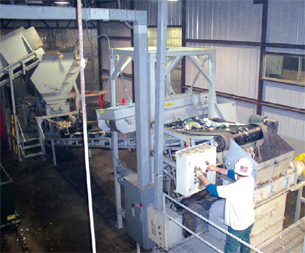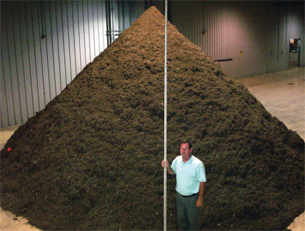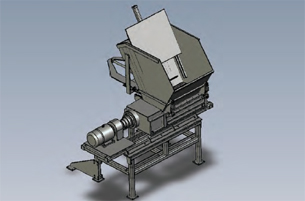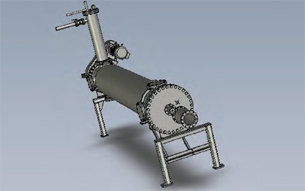Latest News
April 1, 2008
By Margaret S. Gurney
 WastAway’s process is massive, involving a series of machines requiring a building 265 feet long and100 feet wide. The shredder shown here is just one of many used in Bouldin & Lawson’s process. |
Instead of piling our garbage in landfills, imagine a world where all our waste could be turned into useful, vital material. That world is a little closer because Bouldin & Lawson LLC of McMinnville, TN, used SolidWorks to design a waste-to-energy machine that converts “household” garbage into a wood pulp-like substance called Fluff, which can, in turn, be used as potting material for plants or as a fuel to generate electricity. Ongoing development is also looking into extruding the material into construction materials.
Bouldin & Lawson is a 49-year-old horticultural company that has been developing machines that mix soil with fertilizer, vermiculite, peat moss, etc., and inject that mix into pots. It also designed its own machinery to insert trees and shrubs into those pots as well as set up an automatic watering system for nurseries.
According to Larry Flatt, executive vice president at Bouldin & Lawson, the company was looking at its future and trying to find ways to supplement the demand for peat moss (a nonrenewable product) when, in his words, the “innovative and creative juices started flowing.”
 This pile of Fluff is a wood pulp-like material made from processed household waste and can be usedas a potting mix and is being considered as a synthetic fuel. |
Untouched Trash to Riches
The Bouldin & Lawson team knew that landfills had been using chipping and shredding technology for wooden boxes, palettes, and the like, for some time and figured out that modifying the process for a wider variety of materials would be valuable. So the company purchased a machine from SSI, a manufacturer of shredding and waste reduction systems in Oregon and started developing a new process for reusing recycled garbage.
Initial design work started with AutoCAD 14 four years ago to begin making preliminary flat 2D drawings and take them through their initial R&D phases. But the company realized it was missing lots of potentially vital information (i.e., a structural analysis) so it invested in a SolidWorks package.
Engineers used SolidWorks’ sheet metal capabilities to design each enclosure, mount, and assembly to exact specifications to fit on the existing SSI shredder box. Designers also developed stands, hoppers, and even a safety device that protects workers — who may need to enter the machine to remove whatever might be binding it up — from the machine’s treacherous teeth.
SolidWorks analysis tools also enabled engineers to reduce prototyping costs by enabling them to ensure moving parts such as two 20-in. steel blades running at 1,000 rpm don’t collide. The software helped them verify motors would both fit correctly and run cool and efficiently.
“SolidWorks gives our designers the courage to try things they wouldn’t have dared in 2D,” said Flatt. “Our designs have evolved from soapstone sketches on a concrete garage floor to 2D AutoCAD sketches and now 3D models. That evolution has opened new doors to design creativity, streamlining routine CAD functions so we can focus on discovering new approaches to machine design.”
 SolidWorks enabled Bouldin & Lawson’s engineers to reduce prototyping costs by enabling them toensure moving parts such as blades running at high speeds don’t collide. |
Wood, plastic, and food scraps
As a result, Bouldin & Lawson developed a process that is operated by a sister division, Wastaway. The process requires a building 265 feet long and 100 feet wide to handle thousands of pounds of waste per day. Specifically, this trash includes paper, woodchips, and all biodegradable materials, of course, plus some recyclables you might not expect. The stuff that is dumped on WastAway’s tipping floor also contains household plastics, metals, or waste from the meat industry; anything that a municipal solid waste (MSW) outfit would collect from residents and industries in its region. Exceptions are hazardous waste like batteries, paint, waste oil, and the like.
Garbage is dumped into a hopper that leads to a shredder that starts chopping and slicing. The garbage then proceeds through a front-end reduction machine and along magnetic rollers to separate ferrous metals. This continues until particles are reduced to about an inch square. These particles are then fed through the hydrolyzer, a patented steam chamber that agitates and exposes the contents to high temperatures in a pressurized oxygen-less chamber, breaking down organic compounds to produce Fluff now composed of particles no larger than two inches.
“The particle reduction and hydrolyzing process reduces the incoming waste stream to a harmless mix of components that are safe to handle,” explains Flatt. “This is the stuff that is ready to go to potting soil material or other uses; some of which are still in the R&D phase.”
 Above is Bouldin & Lawson’s patented steam chamber or Hydrolyser, which is the only component of its nature to continuously transform the processed waste into a safe and multiuse byproduct. The steam chamber makes the transformation much faster,more economical, and more environmentallyfriendly than other waste conversion technologies. (Diagrams courtesy of Bouldin Corp.) |
Nurseries mix the Fluff with additives, place it in pots, and virtually eliminate the need to use peat. The company sells the Fluff to a company onsite, which distributes it in bulk via trucks and bags to sell on the open market. The company says independent lab testing has shown volatile organic compounds produced by the process are well below acceptable levels.
Applications Worldwide
“For the last four years, 95 percent of our county’s entire waste stream is recycled,” said Flatt, referring to Warren County, TN, which has been using the WastAway process to convert the waste of a population of about 38,000 to Fluff.
“We have developed the machinery to collect anything that residents leave curbside for trash pickup, shred it, remove hard metals, and turn it into a usable byproduct that has applications both in soil and in generating electricity.”
With the first generation of the machine complete, Bouldin & Lawson is working with Aruba to customize a shredding system for the island. Bouldin & Lawson plans to serve as project manager including fabrication, installation, start-up, and initial operation, according to Flatt.
The next project on the line, Series 200, is currently on the drawing board. It is a system suitable for townships, states, or corporations that would ultimately create fuel or electricity by putting the Fluff byproduct through secondary processes to convert it into a liquid fuel or steam to produce electricity.
It’s no surprise that in these days of a crucial green movement to combat global warming that inquiries are received on almost a daily basis, says Flatt, from places such as Greece, Holland, Canada, and several island nations.
While one major benefit of this new technology is reducing the expanse of landfills, Flatt admits that there is one disadvantage to all of this. Landfills call for a low processing fee. Currently, his processing fee costs more than the average U.S. landfill. But in an era where innovation could create a more sustainable lifestyle for the people on this globe, “heads are turning in our direction,” Flatt says.
Were it not for the engineering research and development — made possible in this instance through SolidWorks — the company’s 3D drawings that allowed demonstrations of rotating proposed machinery before prototyping, looking at it from all angles, safeguarding the wellbeing of the company’s clientele, and enabling engineering adjustments throughout the process, this serious advancement toward creating electricity — and ultimately a much sought-after renewable resource — might still be just a pipe dream.
More Info:
AutoCAD
Autodesk
San Rafael, CA
autodesk.com
Bouldin & Lawson
McMinnville, TN
bouldinlawson.com
SolidWorks
Concord, MA
solidworks.com
Margaret S. Gurney is the editor for new products at Desktop Engineering magazine. To remark on this article, send your comments via e-mail to [email protected].
Subscribe to our FREE magazine, FREE email newsletters or both!
Latest News
About the Author
DE’s editors contribute news and new product announcements to Digital Engineering.
Press releases may be sent to them via [email protected].






